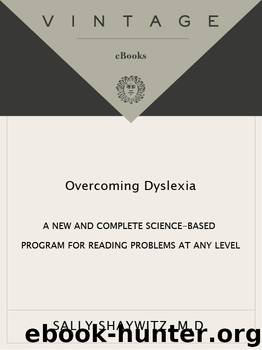Overcoming Dyslexia by Sally Shaywitz M.D

Author:Sally Shaywitz, M.D. [Shaywitz, Sally]
Language: eng
Format: epub
ISBN: 978-0-307-55889-3
Publisher: Knopf Doubleday Publishing Group
Published: 2012-01-04T05:00:00+00:00
Next, give him the examples (write each one down):
Here are some examples: rate, fine, same.
Sequentially, point to the vowel, the consonant, and the silent e at the end and then say each word.
For step three, play a game in which one form of a word is magically transformed into another. You will need the index cards with the pairs of words (such as pan/pane) printed on them. Practice reading one form of the word and then the other. For example, first read the word hid, then point to its cousin with the silent e at the end, hide, and read it, hide. Repeat this for each of the words, and then ask your child to do the same. Once he seems to have grasped the idea, alternate, sometimes beginning with the word with the silent e and then reading the other word (rate, then rat). At other times start with the short form (rat) followed by the word with the silent e at the end (rate).
You can then apply the rule to real-life reading. Ask your child to get a book that he is familiar with and enjoys. With you by his side, have him take a highlighter and mark and read each word following the silent e code. Your child will master the exercise and enjoy his ability to read the many words he can now decipher with his secret code.
Here are forty word pairs to begin with. Copy each pair onto an index card.
bit, bite cub, cube cut, cute
can, cane cap, cape cod, code
con, cone Dan, Dane dim, dime
fad, fade fat, fate fin, fine
fir, fire hat, hate hid, hide
hop, hope kit, kite Jan, Jane
man, mane mad, made mat, mate
not, note pal, pale pan, pane
pin, pine rat, rate rid, ride
rip, ripe rob, robe rod, rode
Sam, same Sid, side sit, site
tam, tame tap, tape Tim, time
Tom, tome tub, tube van, vane
win, wine
You can also use magnetic letters to make word pairs with and without the silent e. Spell out pal, for example, and ask your child to spell out pale. Conversely, begin with pale, ask him to pronounce the word, and then ask if he can transform pale into pal by removing the magnetic e.
Saying c’s. You can help your child understand why the c in cent is pronounced one way and the c in can another. Share the rule with him, give him some examples, and then practice applying the rules governing how to say the letter c whenever it is encountered in words. The rule is: When the letter c is followed by the letters e, i, or y, it is pronounced softly like an ssss, as in cent and cinnamon. When the letter c is followed by a consonant or the vowels a, o, or u, it makes a hard c or k sound, as in car and cup.
You can help your child practice the different sounds by writing different c words on your index cards, some followed by the letters e, i, or y that produce
Download
This site does not store any files on its server. We only index and link to content provided by other sites. Please contact the content providers to delete copyright contents if any and email us, we'll remove relevant links or contents immediately.
The Art of Coaching Workbook by Elena Aguilar(50990)
Trainspotting by Irvine Welsh(21520)
Twilight of the Idols With the Antichrist and Ecce Homo by Friedrich Nietzsche(18504)
Fangirl by Rainbow Rowell(9098)
Periodization Training for Sports by Tudor Bompa(8171)
Change Your Questions, Change Your Life by Marilee Adams(7637)
This Is How You Lose Her by Junot Diaz(6796)
Asking the Right Questions: A Guide to Critical Thinking by M. Neil Browne & Stuart M. Keeley(5649)
Grit by Angela Duckworth(5525)
Red Sparrow by Jason Matthews(5391)
Paper Towns by Green John(5092)
Room 212 by Kate Stewart(5040)
Ken Follett - World without end by Ken Follett(4646)
Housekeeping by Marilynne Robinson(4348)
The Sports Rules Book by Human Kinetics(4296)
Double Down (Diary of a Wimpy Kid Book 11) by Jeff Kinney(4208)
Papillon (English) by Henri Charrière(4199)
The Motorcycle Diaries by Ernesto Che Guevara(4016)
Exercise Technique Manual for Resistance Training by National Strength & Conditioning Association(3957)
